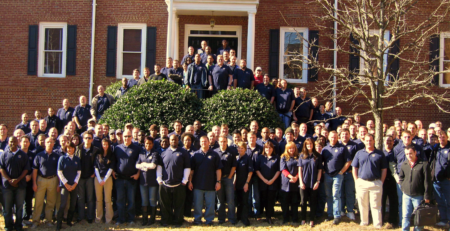Upgrade MCSE to MCITP: Windows 2008 Enterprise Administrator at CED Solutions
[singlepic id=908 w=320 h=240 float=right]Students attending the Triple MCITP: Windows 2008 Desktop Administrator, MCITP: Server Administrator; and MCITP: Enterprise Administrator Boot Camps at CED Solutions will receive a fully-licensed copy of Window 2008 Server.
Topics and learning points for the course are:
Increasing Security
- Identity and Access Management The backbone of any IT enterprise is identity management-ensuring the right person or application can access the data they need, while protecting it. Windows Server 2008 R2 Identity and Access Management solutions provide further enhancements to the directory services core, as well as associated services, such as Rights Management and Certificates. Windows Server Identity and Management solutions have been evolving to meet the ever-changing needs of IDA from internal and external access, to the ever increasing boundaries of the enterprise supporting “anytime, anywhere, on any device” access.
- Security and Policy Enforcement Helping to ensure users and computers connecting to your network comply with your company’s security policy requirements is a priority in today’s business. In addition to the standard policy enforcement that Windows Server has provided for some time, Windows Server 2008 R2 enhances these core features while supporting new platforms, such as Network Access Protection (NAP). NAP helps ensure that you are in control when users and computers are trying to access your network. NAP can make certain that connections have all the latest critical updates, antivirus software, have a functional host firewall, and so on. If not, NAP is also designed to allow you to quarantine them and guarantee they are updated before being allowed on your corporate network.
Reducing Costs
- Server Virtualization and Consolidation In a production environment, having a server which averages only 5-percent CPU utilization costs both time and money. Windows Server 2008 R2 provides key virtualization functionality through Windows Server Hyper-V which enables you to consolidate multiple server roles as separate virtual machines running on a single physical machine. The approach lets you reduce server sprawl and maximize server utilization of your current hardware-and each server can run in its own isolated environment for greater security and easy management.
- Web and Application Platform Climbing higher is what Windows Server 2008 R2 strives for in supporting Web applications (and applications in general). We have seen significant enhancements in security and patching, administration tools, configuration and deployment, and diagnostics and extensibility. Each of these areas ensures that both the Web and application platform provide a solid foundation for your business.
Increasing Productivity
- Branch and Global Office Today’s enterprises consist of corporate headquarters, subsidiaries, branch offices, remote offices, and satellite sites scattered all over the world. Many of these don’t have IT support locally, and people who have no expertise in IT maintenance usually have hands-on access to your remote servers. Maintaining control over security, management, and reliability is a must. Windows Server 2008 R2 builds on previous global office platforms and introduces new technologies focused on branch and remote office environments, from Read-Only Domain Controllers to ensure secure identity management, Distributed File System (DFS) replicas to help protect your digital assets, and improved performance for branch offices. Driven by challenges of reducing cost and complexity of branch IT, organizations are seeking to centralize applications. As they do, however, their dependency on the availability and quality of the WAN link increases. A direct result of centralization is the increased utilization of the WAN link, and the degradation of application performance. Recent studies have shown that despite the reduction of costs associated with WAN links, WAN costs are still a major component of enterprises’ operational expenses. By locally caching frequently used content on the branch office network, the BranchCache feature in Windows Server 2008 R2 and Windows 7 Client reduces the network utilization on WAN links that connect branch offices and improves end user experience at branch locations. As remote branch clients attempt to retrieve data from servers located in the corporate data center, they store a copy of the retrieved content on the local branch office network.
- Simplified Remote Connectivity for Corporate Computers by Using the DirectAccess Feature One common problem facing most organizations is remote connectivity for their mobile users. One of the most widely used solutions for connecting remote users is a virtual private network (VPN) connection. Depending on the type of VPN, users may need to install VPN client software on their mobile computer and then establish the VPN connection over the Internet. The DirectAccess feature in Windows 7 and Windows Server 2008 R2 allows Windows 7 client computers to directly connect to intranet-based resources without the complexity of establishing a VPN connection. The user has the same connectivity experience both in and outside of the office.
- High Availability and Clustering Ensuring your systems are up when you need them is core to any enterprise, and Windows Server 2008 R2 helps ensure greater reliability and availability than ever before. Further enhancements in network load balancing and clustering will make certain that critical applications and services are always available when you need them to be.
- Server Management Windows Server 2008 R2 contains a slate of new and improved tools for managing Windows Server environments within your enterprise. These include Server Manager, which has been enhanced as a single source to manage all your server roles and features (including a command-line version), and Windows PowerShell, a new technology providing a programmable command-line shell and scripting language to manage many features and functions of the server, to name only two.
- Storage and Print Solutions Although storage and printing solutions have been around for a very long time, Windows Server 2008 R2 continues to make advances in both of these core technologies, extending easier printing to Terminal Server environments, creating new wizards for activities, such as provisions storage and managing volumes and shares, and introducing a new technology-Windows File Classification Infrastructure. Windows Server 2008 R2 File Classification Infrastructure (FCI) provides insight into your data by automating classification processes so that you can manage your data more effectively and economically. FCI does this by enabling you to automatically classify files based on properties defined by administrators (such as whether or not a file contains personally identifiable information) and performing administrator-specified actions based on that classification (backing up files containing personal information to an encrypted store, for example). These mechanisms are included in the box as well as provided by extensible interfaces that allow IT organizations and partners to build rich end-to-end solutions for classifying and applying policy based on classification. FCI helps customers save money and reduce risk by managing files based on their business value and business impact.



